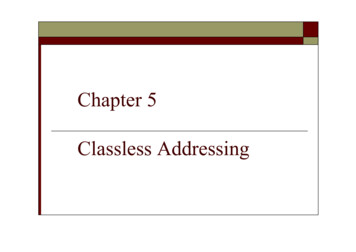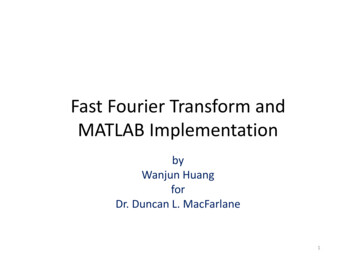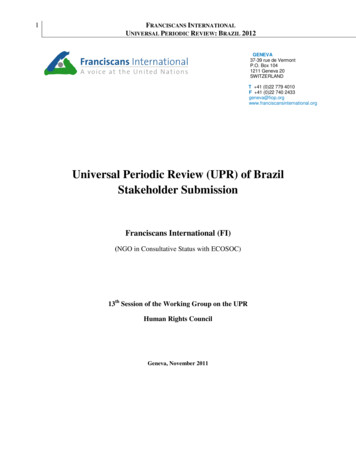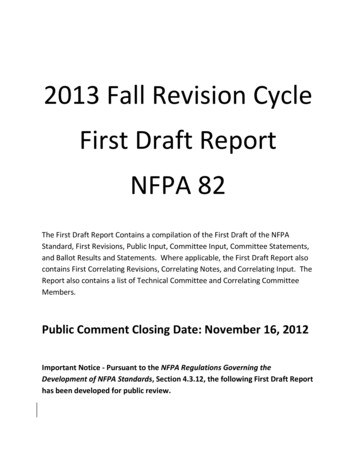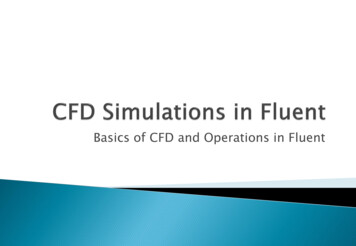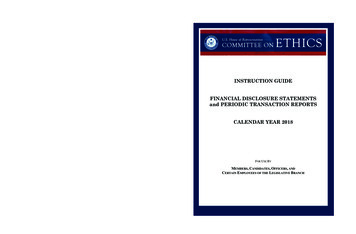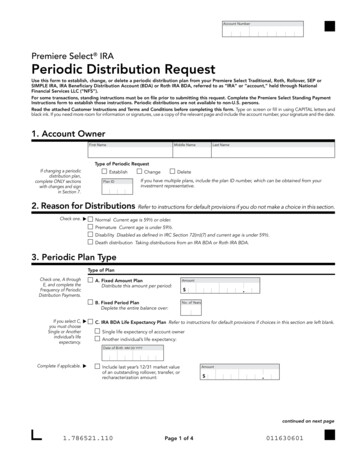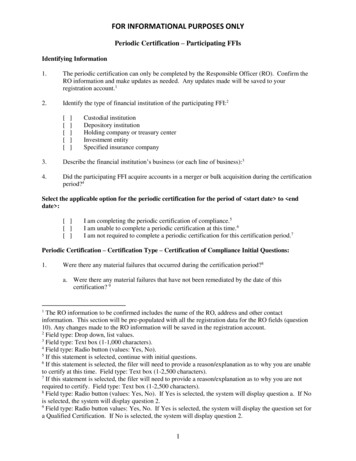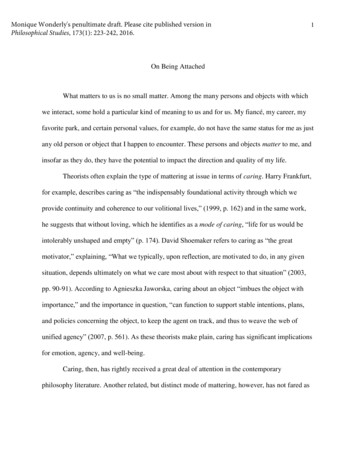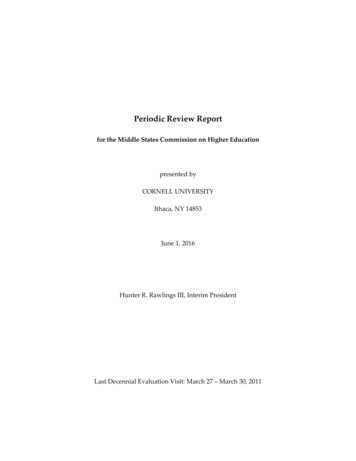
Transcription
Periodic Review Reportfor the Middle States Commission on Higher Educationpresented byCORNELL UNIVERSITYIthaca, NY 14853June 1, 2016Hunter R. Rawlings III, Interim PresidentLast Decennial Evaluation Visit: March 27 – March 30, 2011
Table of Contents1. Executive Summary . 1Institutional Overview . 1University Mission & Vision . 1Cornell’s Colleges and Schools . 1Institutional Approach to the Preparation of the PRR . 4Major Institutional Changes and Developments . 5Leadership Transitions . 5Cornell Tech Campus. . 6Cornell College of Business . 6Highlights of the PRR . 62. Cornell’s Response to Recommendations . 8Commission Recommendations . 8Cornell’s Own 2011 Self-Study Recommendations. 8From “Chapter 1: Institutional Stewardship” (Standards 2, 3, and 7) . 9From “Chapter 2. Integrity, Governance, and Administration” (Stds 3, 4 and 7) . 10From “Chapter 3. Student Admissions and Supports (Standards 8 and 9) . 13From “Chapter 4. Faculty” (Standard 10) . 17From “Chapter 5. Educational Offerings (Standards 11, 12, and 13) . 21From “Chapter 6. Assessment of Student Learning” (Standard 14) . 29From “Chapter 7. Institutional Assessment” (Standard 7). 303. Challenges and Opportunities . 33New Leadership .Budget Pressures and the New Budget Model .New Academic Units .Cornell Tech .Cornell College of Business .Engaged Cornell.333435353639
eHub .New Academic Programs .Biomedical Engineering Major .Africana Studies Ph.D. .394040414. Enrollment and Finance Trends . 425. Assessment of Institutional Effectiveness & Student Learning . 45Institutional Effectiveness (Standard 7) .Comparative Metrics .The Cornell Budget Model .New Strategic Planning Process .Instructional Space Study.Student Learning Assessment (standard 14) .Assessment Infrastructure .University-wide Undergraduate Learning Goals .Learning Goals within the Colleges.Assessment within the Colleges .Assessment beyond the Colleges .45464647494949525455746. Linking Planning & Budgeting Process . 76Monitoring Administrative Costs . 77Managing Financial Aid Costs . 77Developing a Housing Master Plan . 79Cornell University Periodic Review Reportii
1. Executive SummaryInstitutional OverviewUniversity Mission & VisionCornell University is a private Ivy League university and the land‐grant university forthe State of New York. Cornell’s mission is to discover, preserve, and disseminateknowledge; produce creative work; and promote a culture of broad inquiry throughoutand beyond the Cornell community. Cornell also aims, through public service, toenhance the lives and livelihoods of our students, the people of New York, and othersaround the world.Cornell University will be widely recognized as a top‐ten research university in theworld, and a model university for the interweaving of liberal education andfundamental knowledge with practical education and impact on societal and worldproblems.Cornell’s Colleges and SchoolsAs shown with some detail in Table 1, Cornell University enrolls more than 22,000students through its degree‐granting colleges and schools. By design, CornellUniversity’s colleges exercise considerable autonomy from one another and from thecentral administration. Each defines its own academic programs, operates its ownadmissions and advising programs, and establishes the requirements for its owndegrees.Cornell University is a private institution, but three of its undergraduate colleges(Agriculture & Life Sciences, Human Ecology, and Industrial & Labor Relations) as wellas the College of Veterinary Medicine are operated under statutes, appropriations, andcontracts with New York State; these colleges are referred to as the “contract colleges” orthe “statutory colleges.” The remaining units are referred to as the “endowed colleges.”
Table 1. Student Enrollment Headcounts (Fall 2015) by College* and Degree ObjectiveResearch DegreesBachelor’sDegrees(BA, BS, Master’sCollegeBArch) (MA,MS)PhDUndergraduate Endowed CollegesArchitecture, Art & Planning4973331Arts & Sciences4,106781,128Engineering3,060138823Hotel Administration95026Undergraduate Contract CollegesAgriculture & Life Sciences3,433136551Human Ecology1,21037114Industrial & Labor Relations9701435Professional Colleges43Johnson8Law114Vet Medicine180446Weill Cornell Medicine†Grand Total14,226618Professional DegreesMaster’s DoctoralDegrees(DVM,(MPS, etc.) JD, 178803,1524049225623994221,383268*Cornell units not in this table include the Graduate School, Computing & Information Science, ContinuingEducation & Summer Sessions, and Cornell Tech. In addition, the new Cornell College of Business is expectedto be launched in Fall 2016. See below for information about these units.†There are an additional 291 students enrolled at Weill Cornell Medicine-Qatar.The undergraduate, endowed colleges are: College of Architecture, Art, and Planning (AAP). Cornell’s smallestundergraduate college, AAP’s offerings include the distinct five‐year Bachelor ofArchitecture program. College of Arts & Sciences (CAS). The oldest and largest college, CAS offersstudy in the humanities, in the physical and natural sciences, and in the socialsciences. College of Engineering (COE). At the undergraduate level, COE offers thirteenmajors. Many Cornell Tech (see below) faculty members are appointed throughCOE, and COE also provides curricular oversight for the relevant master’sprograms at Cornell Tech. School of Hotel Administration (SHA). SHA was the first collegiate program inhospitality management and today is regarded as the world leader in its field.SHA will join the new Cornell College of Business (CCB) in 2016.Cornell University Periodic Review Report2
The undergraduate, contract colleges are: College of Agriculture and Life Sciences (CALS). The third largest college ofagriculture in the United States, CALS includes the Dyson School of AppliedEconomics & Management; the Dyson School will join the new Cornell College ofBusiness (CCB) in 2016 while also remaining a part of CALS. College of Human Ecology (CHE). CHE brings together natural sciences, socialsciences, and design to advance the human condition. School of Industrial and Labor Relations (ILR). ILR creates and disseminatesworkplace‐relevant knowledge.Cornell’s seven “undergraduate” colleges do not solely prepare undergraduate students,but graduate education is primarily administered through the Graduate School ratherthan through the undergraduate colleges. Graduate School. Cornell’s graduate research degrees (including the MS, theMA and the PhD) are awarded through the Graduate School. Distinct from theadministrative boundaries of departments and colleges, Cornell’s GraduateSchool is organized by “fields,” where graduate “fields” are groups of facultywith shared academic interests who wish to exercise responsibility for theadmission, education, and, as appropriate, financial support of graduatestudents. The Graduate School includes more than 90 degree‐granting fields.Cornell’s also has four professionally‐focused colleges: Johnson Graduate School of Management (JGSM). In addition to MBAprograms in Ithaca, JGSM offers an MBA program through Cornell Tech, and anExecutive MBA dual‐degree program with Queen’s University of Canada. JGSMwill join the new Cornell College of Business (CCB) in 2016. Law School. In addition to the JD and LLM programs in Ithaca, Law also offersthe LLM in Law, Technology and Entrepreneurship through Cornell Tech. College of Veterinary Medicine (CVM). The five academic departments in CVMspan basic biomedical research, translational biology, and clinical and diagnosticmedicine. The CVM is a contract college. Weill Cornell Medicine (WCM). Based in New York City, WCM encompassesboth the Weill Cornell Medical College and the Weill Cornell Graduate School ofMedical Sciences. WCM also operates in Doha, Qatar.Cornell University Periodic Review Report3
In addition to the degree‐awarding colleges and schools, Cornell includes: Cornell Tech is a new technology‐focused campus located in New York City.Approved by the Middle States Commission on Higher Education in August2012, Cornell Tech offers six master’s degree programs in addition to PhDs infour engineering fields. Degrees earned while at Cornell Tech are awarded by therelevant academic units in Ithaca. The Cornell Tech campus is temporarilylocated in the Chelsea neighborhood of Manhattan while its permanent home isbeing constructed on Roosevelt Island. Faculty of Computing and Information Science (CIS). CIS engages with everycollege at Cornell in offering computing and information science programs.Students are enrolled through the degree‐granting units listed above. School of Continuing Education and Summer Sessions (CESS). CESS strives toprovide educational opportunities for any person, in any study, at any time, andin any place. Year‐round offerings enroll some 7,500 students, persons of all agesand all interests, in more than 900 classes and programs annually.As noted below in “Major Institutional Changes and Developments,” a Cornell Collegeof Business is currently being formed.Institutional Approach to the Preparation of the PRROur approach to the Periodical Review Report has been a continuation of the self-studyprocess that culminated in our 2011 reaccreditation. Rather than dissolving theAccreditation Steering Committee in 2011, a subset of the team that managed the selfstudy process and oversaw the preparation of the self-study report has remained intactand provides ongoing attention to compliance with the Characteristics of Excellence. ThisUniversity Accreditation Committee (UAC) is chaired by one of the co-chairs of the 2011Accreditation Steering Committee: Alan Mathios, a current Middle States Commissioneras well as the Rebecca Q. and James C. Morgan Dean of the College of Human Ecology.The UAC managed the production of Cornell’s 2013 Progress Report, and has met on anongoing basis since the 2011 site visit in order to enhance and support Cornell’s cultureof accountability.Two members of this UAC—the chair, Alan Mathios, and the Accreditation LiaisonOfficer, Marin Clarkberg—attended the PRR training event in Philadelphia in (March2014), and reported back to the group on best practices for creating the PRR. Cornell’sself-study contained 42 UAC recommendations, and the UAC members dividedCornell University Periodic Review Report4
responsibility for documenting progress on those recommendations. Similarly, UACmembers each volunteered to take initial responsibility for other sections of the PRR.UAC members were able to draw on rich documentation of institutional processes andassessments, including the annual reports of the Deans to the Provost. As these pieceswere gathered, one member of the UAC took responsibility for compiling the varioussections into a single document for committee review and additional editing.Once a readable draft was compiled, the document was shared with universityleadership, including the Acting President and Provost, the Vice Presidents, the ViceProvosts and the college Deans. A draft was posted on Cornell’s public accreditationwebpage1, and the Provost reported on our progress to the Board of Trustees.Major Institutional Changes and DevelopmentsLeadership TransitionsSince our last accreditation visit, Cornell has experienced a number of leadershiptransitions, including the President, both provosts, academic deans, and vice presidentsas enumerated in Chapter 3,“Major Challenges and Opportunities.”Cornell’s 13th president, Elizabeth Garrett, took office on July 1, 2015, and Ithaca’sprovost, Michael Kotlikoff took office one month later, on August 1st. On February 8,2016, President Garrett announced that she had been diagnosed with colon cancer. Thismessage was followed two weeks later by a message from the Chairman of the Board ofTrustees Robert S. Harrison that President Garrett had undergone surgery related to herillness and that Provost Kotlikoff would serve as Acting President, as provided by theUniversity Bylaws. On March 6 2016, Elizabeth Garrett passed away.On March 24 2016, Chairman Harrison announced that President Emeritus Hunter S.Rawlings III would return to Ithaca to serve as Interim President until a search for the14th Cornell President is completed. Acting President and Provost Kotlikoff will return tohis role as Provost on April 25 when Interim President Rawlings begins hisappointment.The University continues to meet all the fundamental elements of Standard 4, despitethe tragic and untimely loss of President ccreditationCornell University Periodic Review Report5
Cornell Tech Campus.2The establishment of a new technology-oriented campus in New York City in 2012 is oneof the most important developments in the long history of Cornell.A founding principle guiding the foundation of Cornell Tech is that this campus willmaintain a separate budget from the Ithaca campus and from the medical campus. Morethan 700M in philanthropic gifts have already been committed to Cornell Tech (notincluding an additional 100M in funds from New York City), ensuring that Cornell willcontinue to allocate its resources based on its mission and goals (Standard 2) and thatthere are sufficient resources available to attain those goals (Standard 3).As of Fall 2015, there were approximately 160 graduate and professional studentsstudying at Cornell Tech’s temporary location; the Roosevelt Island campus is expectedto open in 2017.Cornell College of BusinessOn January 30th 2016, Cornell’s Board of Trustees amended the bylaws of the Universityto establish the Cornell College of Business (CCB). CCB is anticipated to launch duringthe 2016-17 academic year and will comprise the university’s three accredited businessschools: the School of Hotel Administration, the Dyson School of Applied Economicsand Management, and the Johnson Graduate School of Management.The formal creation of the CCB has stimulated debate and discussion on campus relatingto issues of shared governance (Standard 4), particularly the role of Cornell’s FacultySenate. The plan for the new college is being developed with broad input from Cornellconstituencies, as described in Chapter 3, “Major Challenges and Opportunities.”Highlights of the PRRThe process that resulted in our 2011 self‐study report brought forth 42 specificrecommendations of our own design. A major feature of this PRR is a follow‐up on theprogress related to all of those recommendations (see Chapter 2).Chapter 3 describes some of the most significant challenges and opportunities faced byCornell, including leadership transitions, the formation of new academic units, and thereinvigoration of Cornell’s commitment to outreach.2http://tech.cornell.edu/aboutCornell University Periodic Review Report6
Chapter 4 provides a brief discussion of Cornell’s enrollment and finance trends. Whilewe have experienced some budgetary challenges and have some modest plans forincreasing enrollment, the institution is very stable. An update on our assessmentactivities is provided in Chapter 5, and Chapter 6 provides some examples of howplanning and budgeting processes are linked at Cornell.Cornell University Periodic Review Report7
2. Cornell’s Response to RecommendationsCommission RecommendationsSubsequent to our 2011 self‐study and site visit, the Commission requested a progressreport from Cornell “documenting further progress in the implementation of (1) anorganized and sustainable assessment process, including direct measures, to evaluateand improve institutional effectiveness (Standard 7); and (2) an organized andsustainable process to assess the achievement of student learning goals at the course andprogram levels, with evidence that assessment information is used to improve teachingand learning (Standard 14).” Our April 2013 progress report3 described our efforts toenhance the utility and accessibility of centralized planning data through public(externally facing) and secured (internally facing) data dashboards; to documentprogress of initiatives in support of the strategic plan; to publicize a “Strategic Metrics”dashboard; to assess the impacts of Cornell’s recently‐adopted budget model; and tofurther institutionalize the assessment of student learning outcomes across theuniversity.Cornell’s Own 2011 Self-Study RecommendationsThe process that resulted in our 2011 self‐study report brought forth 42 specificrecommendations of our own design. In the self‐study, these recommendations weregrouped in seven thematic areas that span each of the 14 standards of excellence. Below,they are presented in the order in which they appeared in the self‐study and we brieflysummarize what progress has been made with respect to each of theserecommendations. Given the number and the breadth of the recommendations weoutlined, it should not be surprising that more progress has been in some areas than inothers. To assist the reader, we have classified our progress vis‐à‐vis therecommendation into four categories: unresolved, continuing progress, considerableprogress, and completed. As illustrated in Table 2, we have “completed” and made“considerable progress” on 26 of our 42 recommendations. Sixteen others are continuingto progress, and only one remains ‐MSCHE.pdfCornell University Periodic Review Report8
Table 2. Summary of Cornell’s Responses to the 42 Self-Generated RecommendationsDegree of ProgressRecommendation NumbersNumber ofresponsesUnresolved4.4Continuing Progress2.2, 3.7, 4.2, 4.6, 4.8, 5.1, 5.2, 5.3,5.4, 5.5, 6.1, 6.2, 6.415Considerable Progress1.1, 1.2, 1.3, 3.1, 2.3, 3.2, 3.4, 3.5,3.6, 4.1, 4.5, 4.7, 5.6, 5.7, 5.8, 5.11,5.12, 7.2, 7.319Completed2.4, 3.1, 3.3, 4.3, 5.9, 5.10, 6.3Total Self-Generated Recommendations1742From “Chapter 1: Institutional Stewardship” (Standards 2, 3, and 7)Recommendation 1.1 that Cornell develop a more coordinated approach to planning, followingthe guidelines in the new strategic plan, which is designed to achieve several importantgoals: (1) to affirm general guidelines for organizational stewardship, (2) to make continualimprovements in the stewardship of financial resources, (3) to promote effective stewardshipof the built and natural environment, and (4) to provide cost‐effective infrastructures forinformation technology.Considerable Progress. The development of the new budget model—essential to ourapproach to Standards 2, 3 & 7—was described at length in our 2011 self‐study report.Subsequently, the university hired an external consultant to examine Cornell’s proposedimplementation in detail, and the budget model has been implemented with care.The budget model has improved Cornell’s ability to project financial resources andcosts. In 2014, the Provost configured and convened the Resource Planning Group,comprised of selected deans, vice presidents, vice provosts and faculty members. Thisgroup has projected resources and expenses for five to ten years with considerations oftuition, financial aid, salary improvements, size of workforce, endowment payout,facilities, and so forth.With a new President and Provost there have been several additional working groupsassembled to address recommendation 1.1.Recommendation 1.2 that Cornell develop a plan to refurbish campus facilities, identifying clearpriorities and assigning funding responsibility, sources, and time frame for these needs; andCornell University Periodic Review Report9
Recommendation 1.3 that the university develop its campus infrastructure for the futureaccording to the precepts of the Campus Master Plan.Considerable Progress. Facilities have been a high priority for the Board of Trustees anduniversity leadership since our 2011 self‐study. We have developed estimates of the totalcosts associated with planned (or “deferred”) maintenance and are in the process ofcreating budgetary plans to renew facilities that conform to the internal guidelinestipulating that Cornell will not increase its debt to finance facilities projects. All capitalprojects must now identify resources (such as gifts or reserves) that will enable theproject to be completed as well as operated and maintained over its lifetime. Consistentwith our internal processes, the State University of New York has made criticalmaintenance needs a high priority for its SUNY Construction Fund—a source of capitalfunding for Cornell’s contract colleges.The University has also revamped its capital planning process. The newly formedProvost’s Capital Planning Group4 has been charged with developing and executing astrategy to meet major capital needs, including planned maintenance for individualunits and the campus as a wholeOptimal use of space is another key priority for Cornell and relates strongly to facilityrenewal. In one of her first decisions in office, President Garrett chose not to approve theplans for a new building to house a new department of Biomedical Engineering. Insteadrenewal of existing facilities was chosen to house this high priority program.From “Chapter 2. Integrity, Governance, and Administration” (Stds 3, 4 and 7)Recommendation 2.1 that the university continue to centralize its functions where such actiondoes not jeopardize the fundamental academic missions of the colleges.Considerable Progress. Cornell continues to focus on identifying and implementing costsavings. Since 2011, the university has increased the centralization of purchases to obtainbetter pricing, merged business service centers to increase efficiency, and restructuredthe provisioning of facilities services. In some cases, academic programs were alsoconsolidated or moved to increase efficiency or reduced administrative costs. Forexample, the College of Agriculture & Life Sciences reduced the number of departmentsThe charge to the committee and its membership are described on the ��planning‐group/4Cornell University Periodic Review Report10
in order to better align programs and enhance efficiency. Several units operating directlyunder the Provost’s Office were moved into the colleges to enhance the academic focusof their programs and to leverage colleges’ administrative resources. These movesinclude the Africana Studies and Research Center (moved to the College of Arts andSciences), and the Cornell Institute for Public Affairs (moved to the College of HumanEcology).The work will continue. Indeed, one of the first actions of the new president was to askeach unit to identify and implement efficiencies.5 Units responded6 in December of 2015with ideas relating to aggregating activities to create economies of scale and to avoidduplicating services.Recommendation 2.2 that Cornell better clarify the roles and responsibilities of the assemblies inuniversity governance, as uncertainty can erode the trust between constituent representativebodies and the administration.Continuing Progress. Cornell’s shared governance model includes the Faculty Senate,the undergraduate Student Assembly (SA), the Graduate and Professional StudentAssembly (GPSA), the Employee Assembly (EA), and the University Assembly (UA).The UA includes representation from each of the other four bodies, including theFaculty Senate.Outside of a delineated sphere of decision‐making, the five assemblies act primarily inan advisory capacity to the Provost, President, and Board of Trustees. There arenumerous examples that demonstrate the influences of the assemblies on universitypolicies and practices through this advisory role, such as the Campus Code of Conduct,the Campus Master Plan, oversight of faculty conduct, and the revision of the academiccalendar. That said, there is no consensus regarding how the assemblies—and especiallythe Faculty Senate—should be included in administrative decision‐making processes.There has been an active dialogue within and between the Faculty Senate and theuniversity leadership regarding the role of the faculty in decision‐making as describedin the Bylaws of Cornell University. In particular, with the establishment of the CornellCollege of Business in January 2016, much attention has been given to Article ��tapeResponses to this recent call to action are summarized /.56Cornell University Periodic Review Report11
section 2 of the Bylaws, which states that “the functions of the University Faculty shallbe to consider questions of educational policy which concern more than one college,school or separate academic unit, or are general in nature.”Some faculty members have expressed concern that the creation of the Cornell Collegeof Business occurred without proper consultation with Faculty Senate. The Board ofTrustees and University leaders, on the other hand, have noted that their actions tocreate the Cornell College of Business may be best described as the creation of anorganizational structure (an “empty vessel”), and that it is now the role of the UniversityFaculty to formulate the educational policies that will give real form to the college. Asdescribed in Chapter 3, the process will be guided by seven committees that have broadrepresentation from Cornell’s constituencies.This vigorous, unfolding, and perhaps contentious discussion is very much an attemptto “clarify the roles and responsibilities” of the assemblies in university governance. Ithas brought the question of interpretation of Article XIII, section 2 to the fore, and weexpect to see crisper articulations of roles and responsibilities to emerge from thisdialogue.Recommendation 2.3 that the university devote the necessary change management resources forsuccessful implementation of the significant administrative savings that have beenidentified—even if the financial pressures to do so are alleviated.Considerable Progress. Guided by the work of the Bain Consulting team in 2010, theAdministrative Streamlining Program monitored the achievement of savings gainsand/or provided a forum for discussion of revised goals. These cost savings werecalculated on a yearly basis for a period of time and were considered critical insuccessfully achieving a balanced budget in just a few years following the 2008recession. By Fiscal Year 2013 the University budget was balanced. Administrativestreamlining reduced the operating budget by 59.2 million.7 The most recent call byPresident Garrett for a renewed focus on administrative savings was designed to fostereven more savings and also to prevent complacency that may arise as some financialpressures are reduced.7(see ‐year‐will‐end‐balanced‐budget).Cornell University Periodic Review Report12
Recom
Cornell University is a private Ivy League university and the land‐grant university for . programs in Ithaca, JGSM offers an MBA program through Cornell Tech, and an Executive MBA dual‐degree program with Queen's University of Canada. . Approved by the Middle States Commission on Higher Education in August 2012, Cornell Tech offers .
